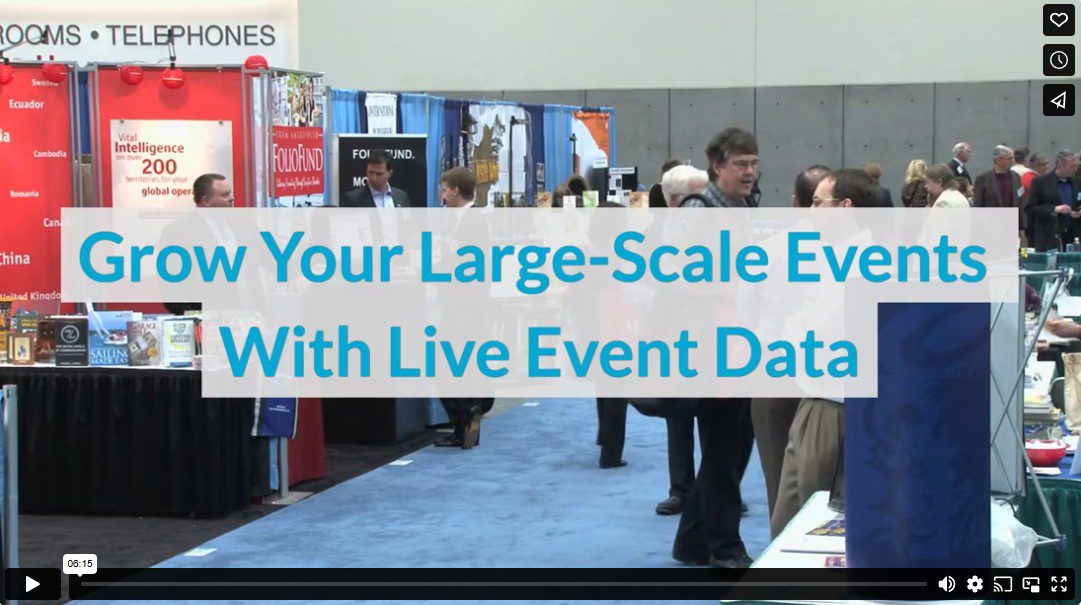When you run a large-scale event, every moving piece matters. From session scheduling to VIP access, attendee check-ins to sponsor activations, the margin for error shrinks with every additional registrant. But what if the biggest differentiator wasn’t the venue, the budget, or even the speaker lineup? What if it came down to how well you use your data?
In high-capacity environments, your ability to track, interpret, and act on event-driven analytics is a must-have. When you lean into the numbers, you unlock a new level of clarity that makes your events more scalable, more profitable, and more repeatable.
Why Event Data is Your Most Underused Growth Lever
As an event operator, you’re constantly making decisions: who gets fast-tracked at check-in, which sessions need larger rooms, where to place sponsor activations, and how to keep attendees moving efficiently. Without clean, real-time data to guide those decisions, you’re left relying on guesswork. And guesswork just won’t work for long.
When your event hits 1,000, 5,000, or 10,000+ attendees, those blind spots turn into bottlenecks. A sponsor loses traffic because their booth was in a dead zone. Your most popular session overflows while another runs half empty. VIP ticket holders miss out on what they paid for because access wasn’t enforced. These moments create friction and chip away at your event’s value and credibility.
The Shift from Reactive to Predictive Operations
You’ve likely experienced the scramble: attendee surges, last-minute registrations, or unanswered questions about session attendance. Without data, these are just problems you react to. But with data, you see them coming.
When you implement real-time event attendance tracking software, you can shift your operations from reactive to predictive. You’ll know which entrances are backing up and deploy staff before it becomes a scene. You’ll see which sessions are surging and reroute overflow traffic proactively. You’ll monitor check-in flow and spot no-show patterns early, giving you the chance to act before a guest complains.
This level of visibility turns your event from “surviving the chaos” to confidently steering the experience.
Data Creates More Value for Everyone
Growth is about doing more and doing it better. When you collect and use attendee data effectively, you can deliver a more personalized, efficient, and meaningful experience for every stakeholder.
For attendees, this means smoother access, smarter scheduling, and offers that actually match their interests. For sponsors, it means clear proof of ROI: visitor counts, engagement stats, and lead data. For your team, it means less scrambling and more strategic focus.
Consider a large conference with RFID event solutions that allow you to monitor attendance and drop-off rates at every session. You can see who engaged the most, which speakers had the strongest draw, and what paths attendees took throughout the venue. This gives you the power to refine future programming, pitch smarter sponsorships, and tailor follow-ups based on genuine interest, not assumptions.
How to Make Your Event Data Work Harder
You don’t need a full data science team to start reaping the rewards of smarter event tracking. You just need systems that talk to each other. That begins with capturing information from the very first click.
Here’s where you start:
- Use a registration platform that captures upgrade choices, demographic insights, and opt-in preferences up front.
- Implement badge-based scanning to track session attendance, exhibitor visits, and VIP access in real time.
- Feed that data into a dashboard that gives your team actionable insights.
Once you’re collecting this kind of data, you can begin to act on it while it’s happening.
Real-Time Data Unlocks On-the-Fly Decisions
At large events, things change quickly. A speaker gets delayed. A room hits capacity faster than expected. A VIP misses the check-in. These aren’t problems you can solve by flipping through a notebook or waiting for someone to report in.
But when your check-in system, badge access, and engagement tools are all connected, you can see who hasn’t arrived and send real-time updates. You can minimize guest complaints by identifying session overcrowding and adjusting seating or room assignments accordingly. You can send staff to high-traffic areas and give updates to your guests in moments.
The ability to make data-driven decisions in real time is what separates high-growth events from the rest. It’s how you maintain control, preserve the experience, and keep your reputation intact, even when the unexpected happens.
The Link Between Data and Revenue Growth
Sponsors are looking for events that prove their value. Attendees are looking for experiences worth coming back to. And your internal team is looking for ways to improve without increasing burnout. Event data gives you a way to answer all of those needs in one place.
With better data, you can:
- Build sponsor packages based on foot traffic and engagement heat maps
- Sell premium ticket tiers that guarantee access to top-performing sessions
- Follow up with attendees based on behavior rather than sending a generic email blast
- Show partners the real return on investment with post-event reporting that goes beyond impressions
The impact: you retain more sponsors, convert more attendees, and grow smarter every time you host.
Build Bigger and Smarter Events
Bigger isn’t better if your backend can’t support it. Growth without systems only amplifies inefficiency. But growth backed by data? That’s scalable, sustainable, and deeply valuable.
If you’re running large-scale events and ready to move from reaction to strategy, you’ll need a platform built to help. With the right system, you’ll have smart check-in, live data dashboards, role-based access tools, and most importantly, control.
Video

